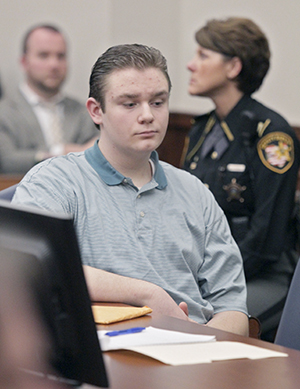Ohio teen faces life after Craigslist conviction

Brogan Rafferty looks on in the courtroom of Judge Lynn S. Callahan in the Summit County Courthouse onTuesday, October 30, 2012, in Akron, Ohio, after a jury reached a guilty verdict on all accounts in the Craigslistmurder trial. Photo by Phil Masturzo/Akron Beacon Journal/Pool/MCT.
October 31, 2012
AKRON, Ohio (AP) — An Ohio teen faces life in prison with no chance of parole for his role in killing and robbing three men and trying to kill a fourth in a deadly Craigslist robbery scheme.
Prosecutors in the weeks-long trial painted 17-year-old Brogan Rafferty as a quick student of violence and a willing participant in three killings, while the defense argued he was acting under the duress of his alleged accomplice, a self-styled chaplain depicted as a mentor.
Rafferty was found guilty Tuesday on the fourth day of jury deliberations in an Akron court.
Authorities say Rafferty, of Stow, helped Richard Beasley, of Akron, lure four victims at separate times with bogus Craigslist job offers to a nonexistent cattle farm in rural Noble County in southeast Ohio; they say the motive was robbery. Authorities say Beasley shot and killed three of the men; the fourth victim was shot in the arm and survived.
Rafferty stood with his hands clasped behind his back and showed no emotion as the verdicts were read. His mother leaned over and cried softly.
Led from the courtroom, Rafferty shook his head and said, “Nothing to say.” He didn’t respond to reporters’ questions about the verdict.
Prosecutors and the defense, who are under a gag order, didn’t comment afterward. The father of victim Timothy Kern flashed a “thumbs up” after the verdicts were read but declined to comment when he left the courtroom.
Jury forewoman Dana Nash and other jurors said it was a difficult decision because of the boy’s age, calling him “a child” on a couple of occasions.
Jurors said they worked on the 25 charges against Rafferty one by one, with the most difficult one involving evidence surrounding the death of the first victim, Ralph Geiger. Rafferty was acquitted of a single identity theft charge involving Geiger.
Jurors debated each charge and often reviewed their own notes and evidence presented at trial, including audio interviews Rafferty gave investigators.
Nash said they were skeptical of some of Rafferty’s testimony, saying they felt as if he contradicted himself at points, as well as in his interviews with investigators.
“We were trying to be fair, and we were fair,” Nash said afterward. “We listened to everything, we observed everything, and we feel we made the right decision.”
Rafferty had testified that he didn’t want to be a part of such violence and said he went along with the plan only because he feared for his life.
Rafferty was tried as an adult but faces a maximum potential sentence of life in prison because he is a juvenile. His sentencing is set for Nov. 5.
Beasley, 53, has pleaded not guilty and could face the death penalty if convicted at his separate trial.
The man who survived, 49-year-old Scott Davis of South Carolina, had testified as the prosecution’s star witness, identifying Rafferty as Beasley’s accomplice and telling a harrowing story of survival.
During Rafferty’s trial, defense attorney John Alexander painted Beasley as the mastermind and said that the first killing came without warning for Rafferty, who “had no idea any of this was going on.”
After the first killing, Alexander said that Beasley warned Rafferty to keep quiet and cooperate by reminding him that he knew where his mother and sister lived.
Prosecutor Emily Pelphrey told jurors that Rafferty chose to participate in the killings, saying he was a “student of violent crime.”
“He made the choices he wanted to make,” she said.
Prosecutors also showed jurors photographs of a suitcase filled with weapons found in Rafferty’s bedroom, including a sawed-off shotgun, a .22-caliber pistol, two knives and ammunition. None of the weapons was conclusively linked to any of the three killings.
Jurors also were shown photos of the graves of the three men killed in the plot and said they were just trying to improve their lives and find work.
The three men were Geiger, 56, of Akron; David Pauley, 51, of Norfolk, Va.; and Kern, 47, of Massillon. Authorities say they were targeted because they were older, single, out-of-work men with backgrounds that made it unlikely their disappearances would be noticed right away.











